
BioMed Central
Page 1 of 6
(page number not for citation purposes)
Cough
Open Access
Short report
The utility of the mannitol challenge in the assessment of chronic
cough: a pilot study
Amisha Singapuri, Susan McKenna and Christopher E Brightling*
Address: Institute of Lung Health, University of Leicester, Glenfield Hospital, Groby Road, Leicester, LE3 9QP, UK
Email: Amisha Singapuri - a_singapuri@hotmail.com; Susan McKenna - sue.mckenna1@btopenworld.com;
Christopher E Brightling* - ceb17@le.ac.uk
* Corresponding author
Abstract
There is a need for more objective outcome measures for chronic cough. In this pilot study we
sought to investigate the utility of the mannitol challenge as a cough-provocation test in non-
asthmatic chronic cough. We studied 16 healthy controls and 13 subjects with chronic cough. We
assessed cough severity using a visual analogue score, capsaicin cough sensitivity, health status using
the Leicester Cough Questionnaire and the dose of mannitol to cause 2 (C2) or 5 (C5) coughs. In
all of the subjects with chronic cough and 6 of the controls we assessed the 1-week repeatability
of the mannitol challenge. We found that in those subjects with chronic cough the geometric mean
(logSEM) mannitol C2 and C5 was heightened compared to controls (C2: 4 (0.2) versus 16 (0.1); p
= 0.04 and C5: 63 (0.1) versus 251 (0.1); p = 0.04). Cough visual analogue score, capsacin-induced
cough sensitivity and health status were also altered in chronic cough compared to healthy
controls, but in those subjects with chronic cough none of these outcomes was correlated with
the mannitol C2 or C5. The repeatability of the mannitol challenge assessed by intraclass
correlation was C2 = 0.53 and C5 = 0.59. A cut-off in the dose of mannitol of 62 mg/ml for C2 and
550 mg/ml for C5 had a sensitivity of 69 and 62% and specificity of 69 and 81% respectively to
distinguish chronic coughers from healthy controls. In conclusion, the mannitol challenge my have
potential as a novel cough challenge test and further work is required to extend our findings and
to assess whether it has utility in different causes of chronic cough.
Findings
Chronic cough is the most common presenting symptom
in primary care; is a significant cause of morbidity and a
considerable health economic burden [1]. The need for
objective outcome measures for cough has lead to the
development of cough challenge tests to assess cough sen-
sitivity [2], health status questionnaires [3] and most
recently the development of cough monitors [4,5]. How-
ever, there remains debate over the clinical utility of these
tests. Asthma is one of the commonest causes of cough [6]
and therefore bronchial challenge is often included in the
clinical investigations of patients with chronic cough. The
mannitol challenge is a novel indirect bronchial challenge
[7,8], which exerts an osmotic effect on the airway and
consequently has the potential to lead to mast cell activa-
tion [9]. One of the early observations in the development
of the mannitol challenge was that it has a tussive effect as
has been reported for methacholine and histamine chal-
lenge tests [10]. Indeed asthmatics cough more than con-
trols in response to manntiol and this effect is
independent of bronchoconstriction [11]. Therefore the
mannitol challenge has the potential to be used both to
Published: 18 November 2008
Cough 2008, 4:10 doi:10.1186/1745-9974-4-10
Received: 25 September 2008
Accepted: 18 November 2008
This article is available from: http://www.coughjournal.com/content/4/1/10
© 2008 Singapuri et al; licensee BioMed Central Ltd.
This is an Open Access article distributed under the terms of the Creative Commons Attribution License (http://creativecommons.org/licenses/by/2.0),
which permits unrestricted use, distribution, and reproduction in any medium, provided the original work is properly cited.

Cough 2008, 4:10 http://www.coughjournal.com/content/4/1/10
Page 2 of 6
(page number not for citation purposes)
assess airway hyperrresponsiveness and cough sensitivity.
We hypothesised that subjects with non-asthmatic
chronic cough also have a heightened cough in response
to mannitol and that this test may be a valid outcome
measure in chronic cough. To test our hypothesis we
examined the number of coughs induced by mannitol
during a challenge and assessed the 1-week repeatability
of this test in a group of healthy controls and subjects with
non-asthmatic chronic cough.
Subjects were recruited from hospital staff or from the res-
piratory clinics at Glenfield Hospital, Leicester, UK.
Chronic cough was defined as a cough > 8 weeks as per
American College of Chest Physician Guideline (ACCP)
[12]. Healthy volunteers had no respiratory symptoms.
All subjects had normal spirometry, were non-smokers
and had < 10 pack year history. Ethical approval for the
study was given by the Leicestershire, Northamptonshire
and Rutland Research Ethics Committee. All subjects gave
written informed consent. Subjects were assessed on three
occasions prior to the commencement of therapeutic tri-
als for their cough. At visit one, subjects' demographics,
quality of life using the Leicester Cough Questionnaire
(LCQ) [3], cough severity assessed by the visual analogue
score (VAS) [13], spirometry and cough reflex sensitivity
with capsaicin cough challenge [2,14,15] was measured.
All of the subjects with chronic cough and 6 of the con-
trols attended on two further occasions separated by one
week (visits 2 and 3) where spirometry and the mannitol
challenge were completed. In brief, mannitol dry powder
capsules (Gift from Pharmaxis) were administered in
ascending doubling doses ranging from 5 mg to 635 mg
via an Osmohaler. The FEV1 was measured between each
dose of mannitol to measure a drop in lung function. An
empty capsule was administered prior to the 5 mg dose, as
a placebo. The numbers of coughs within the first 30 sec-
onds following mannitol administration were counted.
The challenge was terminated if the subject's FEV1
dropped by 15% (PD15) or more or when the highest
dose of mannitol had been attained.
All statistical tests were performed using Prism version 4.
The concentration of capsaicin or mannitol that caused
two coughs (C2) and five coughs (C5) were calculated by
the log-dose-response curves. Comparisons between
groups were made using t-tests or Mann-Whitney-U test
for parametric and non-parametric data respectively.
Repeatability was assessed by intra-class correlation and
presented as Bland-Altman plots. Receiver-operator curves
were generated for mannitol C2 and C5. Correlations
were made between the mannitol challenge and other
cough outcome measures using spearman rank correla-
tions. A p-value of < 0.05 was considered to be statistically
significant.
Clinical characteristics for subjects are as shown in table 1.
Of the 13 subjects with chronic cough the final diagnoses
were upper airway cough syndrome 3, gastro-oesophageal
reflux 3, unexplained 3, non-asthmatic eosinophilic bron-
chitis 2, post-infectious 1, chronic bronchitis 1. The sub-
jects with chronic cough had impaired cough-related
health status assessed by the LCQ, increased cough VAS
and heightened cough sensitivity assessed by capsaicin
cough challenge compared to healthy controls. The man-
nitol C2 and C5 were decreased in subjects with chronic
cough compared to healthy controls demonstrating a
heightened response to mannitol (Table 1 and Figure 1).
None of the subjects had airway hyperresponsiveness in
response to mannitol. Receiver-operator curves for man-
nitol C2 and C5 are as shown Figure 2. The area under the
curve was significantly increased for mannitol C2 (mean
[95% CI] 0.73 [0.54–0.91]; p = 0.039) and C5 (0.72
(0.52–0.91]; p = 0.049). A cut-off in the dose of mannitol
of 62 mg/ml for C2 and 550 mg/ml for C5 had a sensitiv-
ity of 69 and 62% and specificity of 69 and 81% respec-
tively (Figure 2). Bland-Altman plots for the within
subject repeatability of the mannitol C2 and C5 are as
shown (Figure 3a, b). The mean [SD] within subject
repeatability for mannitol C2 and C5 was 0.2 doubling-
doses [2.6], and 0.13 doubling-doses [0.9] respectively.
Therefore to detect a difference of 1 doubling-dose in
mannitol C5 13 subjects are required in each group to
have 80% power at the 5% level. The intraclass correlation
was C2 = 0.53 and C5 = 0.59. In the whole group there
were strong correlations between the mannitol C5 and the
total LCQ, its domains and capsaicin C5 (Table 2). These
correlations did not extend to the subjects with chronic
cough alone. Similarly, there were no significant correla-
tions between mannitol C2 and other cough measures in
those subjects with chronic cough.
Table 1: Clinical characteristics
Normal Chronic cough
Number 16 13
Age#48 (4) 54 (4)
Male/Female 7/9 3/10
FEV1% predicted#106 (4) 91 (4)*
FEV1/FVC %#82 (1) 81 (1)
Total LCQ#6.9 (0.01) 5.7 (0.33)*
Physical domain#6.9 (0.03) 5.5 (0.30)*
Psychosocial domain#7.0 (0.0) 6.0 (0.38)*
Social domain#7.0 (0.02) 5.8 (0.44)*
Cough VAS#0.9 (0.4) 29.5 (6.3)*
Mannitol PD15 > 2.8 > 2.8
Capsaicin C2∧16 (0.1) 4 (0.2)*
Capsaicin C5∧251 (0.1) 63 (0.1)*
Mannitol C2∧126 (0.2) 32 (0.2)*
Mannitol C5∧501 (0.04) 316 (0.07)*
#mean (SEM), ∧geometric mean (logSEM), *p < 0.05

Cough 2008, 4:10 http://www.coughjournal.com/content/4/1/10
Page 3 of 6
(page number not for citation purposes)
In this pilot study, we report for the first time that manni-
tol-provoked cough is a repeatable test and is increased in
non-asthmatic chronic cough. The advantages of the man-
nitol challenge compared to more established cough chal-
lenge tests is that administration is simple, whereas other
tests often require preparation of solutions needing labo-
ratory support, and the mannitol challenge provides addi-
tional information on AHR. Our findings support our
hypothesis that mannitol-provoked cough is increased in
non-asthmatic chronic cough as has been reported in
asthma [11]. However, there was considerable overlap in
the mannitol C2 and C5 between subjects with cough and
Table 2: Univariate analysis of the correlations between mannitol C2 and C5 and other cough outcome measures in the whole group
and chronic coughers alone
Mannitol Challenge C2
Whole group
C2
Chronic cough
C5
Whole group
C5
Chronic cough
Age #r = -0.2 p = 0.31 r = 0.17 p = 0.59 r = -.35 p = 0.06 r = -0.47 p = 0.1
Total LCQ r = 0.25 p = 0.19 r = -0.09 p = 0.77 r = 0.47 p = 0.01 r = 0.38 p = 0.2
Physical domain r = 0.23 p = 0.23 r = -0.16 p = 0.6 r = 0.48 p = 0.01 r = 0.40 p = 0.18
Psychosocial domain r = 0.31 p = 0.10 r = 0.12 p = 0.71 r = 0.55 p = 0.002 r = 0.48 p = 0.10
Social domain r = 0.38 p = 0.04 r = 0.18 p = 0.57 r = 0.56 p = 0.002 r = 0.53 p = 0.07
Cough VAS r = -0.31 p = 0.10 r = -0.09 p = 0.77 r = -0.38 p = 0.04 r = -0.32 p = 0.29
Capsaicin C2 r = 0.19 p = 0.45 r = -0.01 p = 0.96 r = -0.04 P = 0.88 r = -0.37 p = 0.22
Capsaicin C5 r = 0.37 p = 0.05 r = 0.05 p = 0.88 r = 0.60 p = 0.006 r = -0.35 p = 0.25
Heightened mannitol cough sensitivity in chronic coughFigure 1
Heightened mannitol cough sensitivity in chronic cough. Mannitol C2 and C5 for subjects with chronic cough and
healthy controls.

Cough 2008, 4:10 http://www.coughjournal.com/content/4/1/10
Page 4 of 6
(page number not for citation purposes)
controls as has been previously observed with other cough
challenge tests [14]. Although, the ROC area under the
curve for mannitol C2 and C5 showed that the accuracy of
the test was good, the sensitivity and specificity of the test
was only fair questioning the predictive value of the test
and therefore its utility. The short-term repeatability was
reasonable, but was not as good as previously reported for
the capsaicin challenge [14]. This pilot study therefore
suggests that further work is warranted to assess whether
the mannitol challenge has a place as a cough outcome
measure.
The cause of mannitol-provoked cough is unknown. It is
likely that it mediates its effect indirectly via activation of
mast cells in the superficial airway to release mediators,
which in turn activate local cough receptors. An earlier
study in asthma demonstrated that the degree of bron-
choconstriction in response to mannitol and the cough
response are independent [11]. This supports the view
that mast cell localisation to the epithelium and airway
smooth muscle are features of asthma, but may co-exist to
different degrees in the same individual [16,17]. Asthmat-
ics with increased mast cell number in the airway smooth
muscle bundle have heightened AHR [15] and it is possi-
ble that the number and state of activation of mast cells in
the epithelium determines the cough response. Future
studies to investigate the mechanisms of mannitol-pro-
voked cough and its relationship to the airway immun-
opathology are required.
There a number of potential shortcomings of our study.
This was a pilot study of a small number of subjects with
non-asthmatic chronic cough. We are therefore unable to
determine whether mannitol-provoked cough has a
strong association with different causes of cough. Its util-
ity as a cough outcome may therefore differ dependent
upon the aetiology of the cough. We have only assessed
the short-term repeatability. To fully address the clinical
utility of mannitol in the assessment of cough future work
will need to determine repeatability over a longer period
and investigate responsiveness to therapy in more sub-
jects.
In conclusion, the mannitol challenge may have potential
as a novel cough challenge test. However, its repeatability
and ability to discriminate between subjects with non-
asthmatic chronic cough in this pilot study was not yet
sufficient to recommend its routine use. Our findings
Receiver-operator curves for mannitol challengeFigure 2
Receiver-operator curves for mannitol challenge. The receiver-operator curves for C2 (■) and C5 (●).

Cough 2008, 4:10 http://www.coughjournal.com/content/4/1/10
Page 5 of 6
(page number not for citation purposes)
need to be replicated in a larger series of chronic coughers
and in particular it may be informative to examine
response in chronic coughers with different aetiologies.
Competing interests
The authors declare that they have no competing interests.
Authors' contributions
AS and SM undertook the clinical assessments. AS and CB
prepared the manuscript. All authors have read and
approved the manuscript. CB supervised the study.
Acknowledgements
The mannitol challenges (Aridol) were kindly provided as a gift (Pharmaxis,
Sydney, Australia). CB is funded by a Wellcome Senior Clinical Fellowship.
Repeatability of mannitol challengeFigure 3
Repeatability of mannitol challenge. Bland-Altman plots of the 1-week repeatability of a) the mannitol C2 and b) C5.


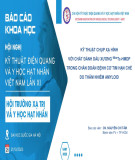
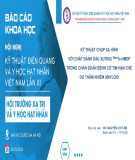
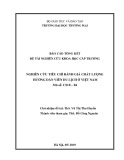
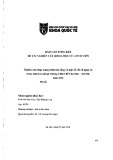
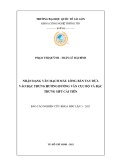
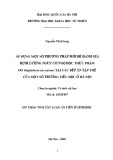
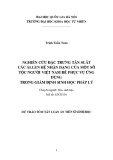
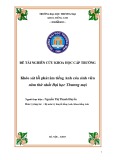
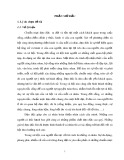





![Báo cáo seminar chuyên ngành Công nghệ hóa học và thực phẩm [Mới nhất]](https://cdn.tailieu.vn/images/document/thumbnail/2025/20250711/hienkelvinzoi@gmail.com/135x160/47051752458701.jpg)









